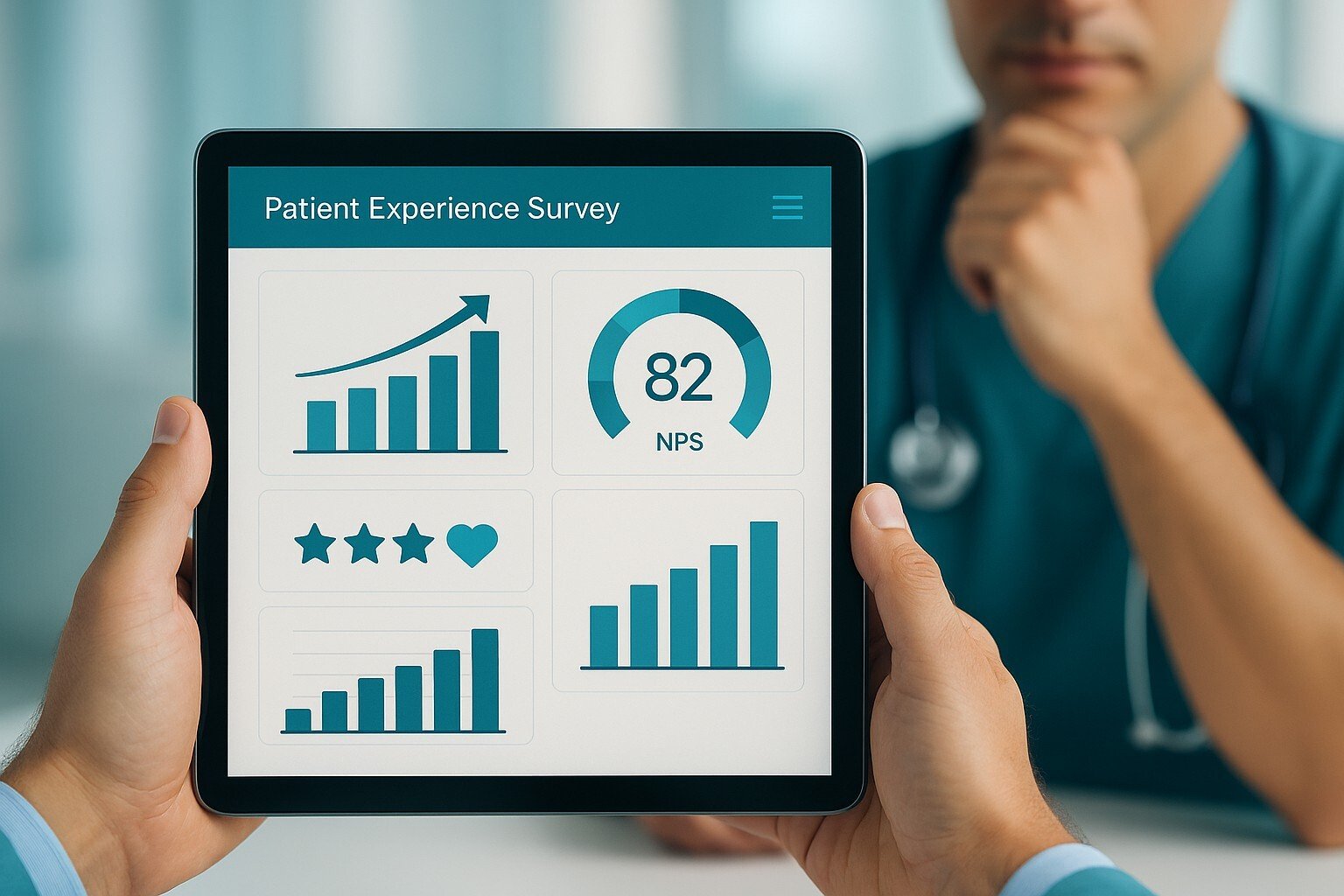The Definitive How-To: How to Create a Patient Satisfaction Survey From Scratch
A patient satisfaction survey is a structured questionnaire designed to capture patient feedback on their experiences with your healthcare services....
16 min read
Alvin Amoroso : 7/23/25 8:16 AM

Learning how to measure patient satisfaction in healthcare is one of a provider's most critical tasks, as it involves systematically gathering, analyzing, and acting on patient feedback to improve every aspect of care delivery. This process goes far beyond simple comment cards; it's a strategic imperative that uses specific tools and methodologies—like surveys, real-time feedback, and data analysis—to understand the patient experience from their perspective. By mastering these measurement techniques, healthcare organizations can identify strengths, pinpoint areas for improvement, and ultimately foster a culture of patient-centered care that enhances both clinical outcomes and operational success.
In this definitive guide, we will explore everything you need to know about measuring and improving patient satisfaction. We will delve into why it's so vital, uncover the key indicators you must track, and provide a comprehensive overview of the core methods and strategies for gathering this crucial feedback. From standardized surveys like HCAHPS to modern digital tools, you will gain the knowledge needed to build a robust patient satisfaction program that drives meaningful change and builds lasting patient loyalty.
Before diving into the "how," it's essential to understand the "why." Measuring patient satisfaction isn't just a box to check; it is a foundational activity that directly impacts nearly every facet of a healthcare organization. The insights gained from this process are invaluable for creating a sustainable, high-quality, and reputable practice. Neglecting to measure patient satisfaction is like navigating without a map—you may be moving, but you have no idea if you're heading in the right direction.
The most important reason to measure patient satisfaction is its direct link to the quality of care. When you systematically listen to patients, you uncover critical information about their care journey that might not be apparent from clinical data alone. Patients can highlight issues in communication, wait times, or post-discharge instructions that, when addressed, lead to better adherence to treatment plans, fewer readmissions, and improved health outcomes. A satisfied patient is more likely to trust their provider, ask important questions, and actively participate in their own care, creating a powerful partnership for better health.
In today's competitive healthcare landscape, patient loyalty is a significant asset. A negative experience can easily cause a patient to seek care elsewhere, while a positive one can create a patient for life. Measuring satisfaction helps you understand what makes patients happy and what drives them away. By addressing their concerns and consistently delivering excellent service, you transform patients from one-time visitors into loyal advocates for your practice. Loyal patients are also more likely to refer friends and family, providing a steady stream of new patients through word-of-mouth marketing—the most powerful form of advertising.
Your organization's reputation is built on the experiences of your patients. In the digital age, a single negative review on Google, Healthgrades, or Yelp can influence hundreds of potential patients. Proactively measuring satisfaction allows you to identify and resolve issues before they escalate into public complaints. Furthermore, demonstrating a commitment to patient feedback and continuous improvement builds a strong, positive brand image. Facilities known for excellent patient care attract not only more patients but also top-tier medical talent who want to work in a patient-centered environment.
For many healthcare organizations, measuring patient satisfaction is a requirement, not a choice. Government bodies and accreditation agencies often mandate the collection and reporting of patient experience data. The most prominent example in the United States is the Hospital Consumer Assessment of Healthcare Providers and Systems (HCAHPS) survey. Performance on these surveys can impact accreditations from organizations like The Joint Commission and can influence public perception through publicly reported scores. Failing to meet these requirements can lead to penalties and a loss of standing in the healthcare community.
Patient feedback is a powerful diagnostic tool for your operations. Are patients consistently complaining about long wait times? This could signal an issue with your scheduling system. Is the billing process a common source of frustration? Your administrative workflow may need an overhaul. By analyzing feedback trends, you can pinpoint bottlenecks and inefficiencies in your processes. Addressing these operational issues not only improves patient satisfaction but also often leads to cost savings and increased staff productivity, creating a more efficient and effective organization.
The shift from fee-for-service to value-based care models means that financial reimbursement is increasingly tied to quality metrics, including patient satisfaction scores. Payers, including Medicare, now adjust payments based on HCAHPS scores and other patient experience data. In this new paradigm, high patient satisfaction is no longer just "nice to have"—it directly impacts your bottom line. Investing in the tools and strategies to measure and improve patient satisfaction in healthcare is an investment in the financial health of your organization. For a deeper understanding of value-based care, you can review expert insights on [your-priority-page-url].
To effectively measure patient satisfaction, you need to know what to look for. These key indicators represent the most important touchpoints in the patient journey. Tracking performance across these domains will give you a holistic view of the patient experience and show you exactly where to focus your improvement efforts. These are the factors that patients consistently say matter most to them.
This is often the most significant indicator of overall satisfaction. Patients need to feel heard, respected, and understood. Key aspects to measure include whether doctors and nurses listened carefully, explained things in a way the patient could understand, and treated them with courtesy. Clear communication reduces anxiety, builds trust, and ensures patients are well-informed partners in their care.
When a patient needs help—whether it's assistance getting to the restroom or an answer to an urgent question—how quickly and effectively does staff respond? This indicator measures the perceived attentiveness of the entire healthcare team. Long delays in responding to call buttons or requests can lead to significant frustration and a feeling of being neglected, severely impacting the patient's sense of safety and comfort.
The physical environment plays a huge role in a patient's perception of quality. A clean, quiet, and comfortable setting can be incredibly reassuring and conducive to healing. This indicator tracks patient perceptions of the cleanliness of their room and the hospital in general, as well as the noise level, especially at night. A tidy and peaceful environment signals that the organization pays attention to detail and cares about the patient's well-being.
For many patients, effective pain management is a top priority. This indicator assesses whether the staff did everything they could to help with the patient's pain. It measures not just the administration of medication but also the communication around pain—how often staff talked to the patient about their pain levels and what treatment options were available. Poor pain control is a major source of distress and dissatisfaction.
Patients and their families need clear information to navigate their care journey. This indicator measures the quality of information provided about their condition, medications, and post-discharge care. Were medication side effects explained clearly? Were written instructions for home care easy to understand? Proper education empowers patients to manage their health effectively after they leave, reducing the risk of complications and readmissions.
How easy is it for patients to get the care they need when they need it? This indicator covers everything from the ease of scheduling an appointment to the amount of time spent in the waiting room. Long wait times for appointments or before seeing a provider are a universal source of frustration. Measuring this helps identify bottlenecks in your scheduling and patient flow processes.
The patient experience doesn't end when they leave the clinic or hospital. The administrative and billing process is a final, and often frustrating, touchpoint. This indicator tracks the clarity, accuracy, and fairness of the billing process. Unexpected charges, confusing statements, and difficulty getting answers to billing questions can sour an otherwise positive clinical experience.
A smooth and well-coordinated discharge is crucial for a safe transition from the hospital to home. This indicator assesses whether the patient felt prepared for discharge and understood their follow-up care plan. It also includes whether the facility followed up with the patient after they went home to check on their recovery. A strong discharge process shows that the organization cares about the patient's long-term well-being.
A robust strategy on how to measure patient satisfaction in healthcare typically involves a combination of these approaches, blending quantitative data with qualitative insights to get a complete picture.
Patient satisfaction surveys are the most common and fundamental tool for measuring the patient experience. They provide structured, quantitative data that can be tracked over time and benchmarked against other organizations.
Standardized surveys allow for apples-to-apples comparisons across different organizations. The most well-known is the HCAHPS survey, which is a cornerstone of public reporting and value-based purchasing.
Why wait weeks to find out about a problem? Real-time feedback tools allow you to capture the patient's impressions while the experience is still fresh in their mind, enabling rapid service recovery.
Your patients are already talking about you online. Listening to these public conversations is an essential, if informal, way to measure patient satisfaction.
While surveys give you the "what," focus groups help you understand the "why." These qualitative sessions provide deep insights into patient perceptions and attitudes.
For the most detailed, personal feedback, nothing beats a one-on-one conversation. In-depth interviews allow you to explore a patient's entire care journey from their unique perspective.
A Patient and Family Advisory Council (PFAC) formalizes the partnership between a healthcare organization and its patients. It is a powerful mechanism for embedding the patient voice into strategic decision-making.
Complaints are not just problems to be solved; they are a rich source of data. A systematic approach to analyzing complaints can reveal deep-seated issues in your organization.
The Net Promoter Score is a widely used metric for measuring customer loyalty, and it has been adapted effectively for healthcare. It is based on a single, powerful question.
Actions speak louder than words. Whether patients return to your practice and whether they refer others are ultimate, behavioral measures of satisfaction.
Though it may seem old-fashioned, a simple suggestion box can still be an effective way to gather anonymous, candid feedback.
Choosing the right tool is essential for efficiently managing your efforts on how to measure patient satisfaction in healthcare. Modern platforms go beyond simple survey creation, offering powerful analytics, benchmarking, and automation features.
These are specialized software-as-a-service (SaaS) solutions designed specifically for the healthcare industry. They offer pre-built, validated survey templates and robust reporting dashboards.
The most effective way to automate feedback collection is to integrate it with your Electronic Medical Record (EMR) or Electronic Health Record (EHR) system. This allows you to trigger surveys automatically based on specific events in the patient journey, such as a completed appointment, a hospital discharge, or a prescription refill. This integration ensures timely feedback collection and allows you to link satisfaction data directly to a patient's clinical record for deeper analysis.
The best tool for you depends on your organization's size, budget, and specific needs.
When evaluating tools, look for these key features:
Collecting data is only the first step. The true value lies in your ability to track and analyze it to generate actionable insights. A systematic approach to analysis is crucial for turning feedback into improvement.
You can't improve what you don't measure. The first step is to establish a baseline—your current level of performance across key satisfaction metrics. Once you have this baseline, you can set specific, measurable, achievable, relevant, and time-bound (SMART) goals for improvement. For example, your goal might be to "increase our NPS score from 45 to 55 within the next 12 months."
Aggregate scores can hide important variations in performance. To get a truly granular understanding, you must segment your data. Analyze satisfaction scores by:
Patient satisfaction is not a static number. It's vital to track your key metrics over time to identify trends. Is satisfaction with wait times getting progressively worse? Did your scores improve after you implemented a new communication training program? Trend analysis helps you understand the impact of your improvement initiatives and provides early warnings of emerging problems.
Quantitative data (the "what," e.g., an average rating of 3.5/5) tells you where a problem is, but qualitative data (the "why," e.g., comments like "the doctor seemed rushed") tells you what the problem is. The most powerful insights come from combining both. Use your survey scores to identify a low-performing area, then dive into the open-ended comments, focus group notes, or interview transcripts to understand the root cause of the issue.
Data is only useful if it's in the hands of the people who can act on it. Create clear, concise, and visually appealing reports tailored to different audiences.
Ultimately, the goal of measuring patient satisfaction is to improve it. Here are some high-impact strategies for turning your data-driven insights into tangible improvements in the patient experience.
Since communication is consistently a top driver of satisfaction, investing in staff training is essential. Programs like communication workshops, role-playing exercises, and empathy training can equip doctors, nurses, and administrative staff with the skills to interact with patients in a more effective and compassionate way.
First impressions matter. Use patient feedback to identify and eliminate friction in your front-end processes. This could involve implementing online scheduling, creating a digital check-in option to reduce paperwork, or simply redesigning the waiting room to be more comfortable and welcoming.
Act on feedback related to cleanliness, noise, and comfort. This might involve changing housekeeping protocols, implementing "quiet hours" on inpatient floors, or investing in more comfortable waiting room furniture. These small changes can have a big impact on a patient's perception of quality.
Use insights from your Patient Advisory Council and other qualitative feedback to redesign care processes around the patient's needs. This could involve things like combined appointments for multiple specialists, more flexible visiting hours, or involving patients and families more directly in care planning meetings.
One of the most powerful ways to build trust is to "close the loop" on feedback. This means not only resolving an individual patient's issue but also communicating back to the broader patient population about the changes you've made based on their collective feedback. This can be done through newsletters, posters in the waiting room, or updates on your website. When patients see that their voice leads to real change, they feel valued and are more likely to provide feedback in the future.
A 5-point Likert scale is a common survey question format used to measure attitudes or opinions. For patient satisfaction, it typically ranges from a highly negative to a highly positive response. A common example would be:
This scale provides quantitative data that is easy for patients to understand and for organizations to analyze.
There is no single "best" tool; the best approach is a combination of tools. A comprehensive strategy includes:
Effective tracking involves a systematic process:
The main indicators of patient satisfaction are the key touchpoints of the care journey that have the biggest impact on a patient's overall perception. These consistently include:
Learning how to measure patient satisfaction in healthcare is not a one-time project; it is an ongoing commitment to listening, understanding, and improving. It is about fundamentally embedding the patient's voice into the fabric of your organization. By leveraging a multi-faceted approach that combines robust surveys, real-time feedback, and deep qualitative insights, you can move beyond simply collecting scores. You can begin to truly understand the lived experience of your patients.
The data you gather is more than just numbers on a dashboard; it is a roadmap for excellence. It shows you how to deliver safer, more effective, and more compassionate care. It strengthens your reputation, ensures financial stability in a value-driven world, and, most importantly, fosters the trust and loyalty that are at the heart of any successful healing relationship. By making patient satisfaction a core tenet of your strategy, you are investing in a healthier future for both your patients and your practice.

A patient satisfaction survey is a structured questionnaire designed to capture patient feedback on their experiences with your healthcare services....

Imagine two patients leave your clinic. One felt rushed, confused by the billing, and unsure about their treatment plan. The other felt heard,...

A patient satisfaction survey is a critical tool that provides a direct line of communication between healthcare providers and the people they serve....